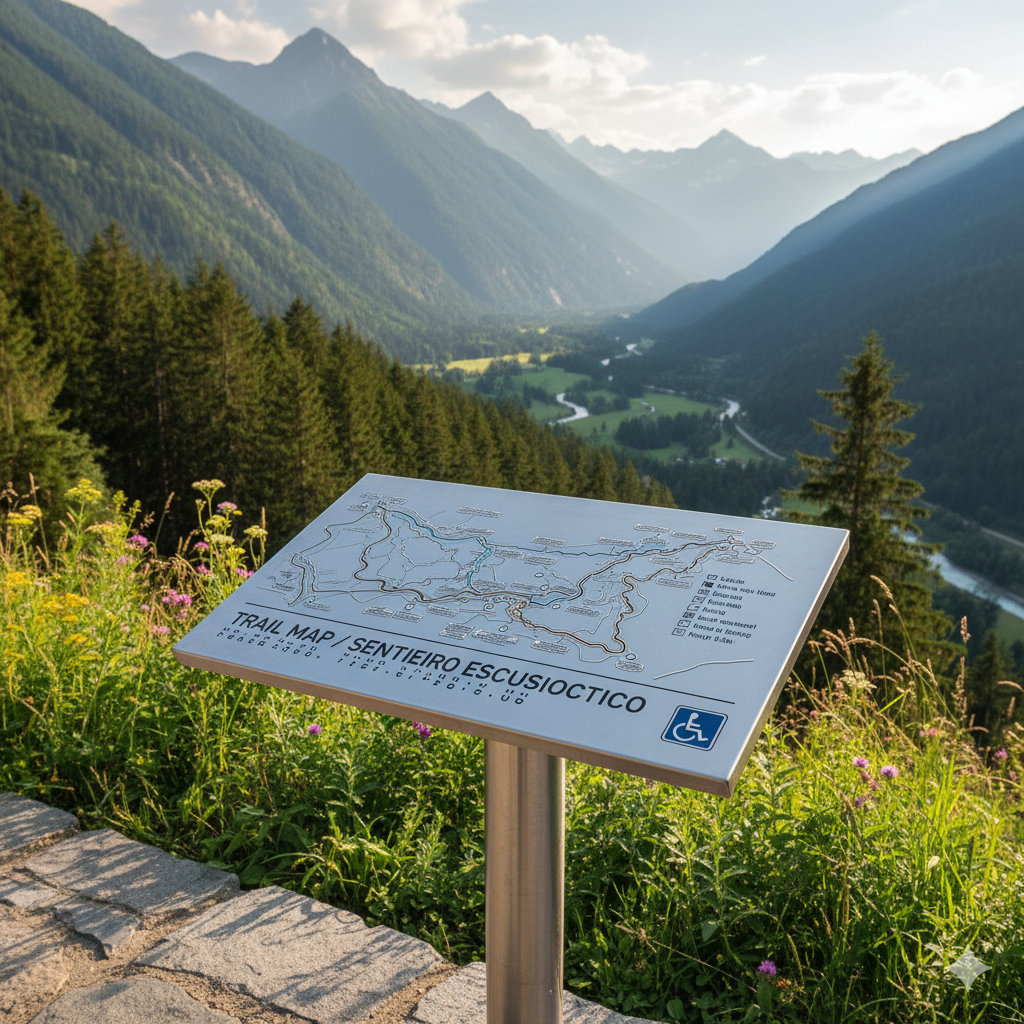
A New Vision of Maps and Tactile Signage.
Accessibility is not just a matter of ramps or elevators, but a comprehensive sensory and informational experience that ensures autonomy and safety in moving for everyone, especially people with visual impairments. Citislab.it is committed to promoting and implementing universal design solutions that transform sensory routes, making them usable without barriers. At the heart of this transformation is signage for the visually impaired and blind: an integrated system of tactile and visual information.
Tactile Signage: Safety and Autonomy in the Urban Context.
Our cities must evolve to accommodate the needs of all citizens. Tactile street signs play a crucial role in this process. These are not just pavements, but a codified and normed sensory language that is essential for outdoor orientation.
Different formats, such as Tactile Maps, Tactile Panels and Placards, and Hazard Indicators, are used strategically:
- Stop and Warning Points: Indicated by special surveys near crosswalks, ramps, stairs or public transportation entrances.
- Guided Routes: Linear tactile strips that safely lead blind or visually impaired people to points of interest or along predetermined paths, avoiding obstacles or dangerous areas.
These arrangements, indicated a priori in our tactile solutions not only prevent accidents but also provide the freedom to move independently, a fundamental right for social inclusion.
Tactile signage and production methodologies
Tactile Maps: a pathway visible by touch
A tactile map is a relief planimetric representation that allows the user to “read” the layout of an area, whether it is a park, the floor plan of a public building, or a train station. Developed with an obsessive attention to clarity and simplicity, these maps combine:
- Geometric Surveys: To represent boundaries, structures and spaces.
- High Contrast Colors: To benefit visually impaired users.
- Braille captions: To identify key points.
Signage and tactile maps strategically placed, such as at the entrance to museums, hospitals, or universities, are an essential reference point for planning one’s internal tactile journey.
Tactile Pathways: Seamless Connection
Tactile and Braille Signs for Signage: Details That Make the Difference
True excellence in accessibility and inclusiveness lies in the information details. Citislab.co.uk offers the design and installation of maps, tactile signs and braille signage systems for timely and critical information.
Tactile Signs and License Plates
Tactile signs go beyond simple bathroom signs. They include:
- Nameplates of installations in the territory: Public Interest Offices, monuments, parks .
- Emergency Information: Evacuation plan (always in tactile/braille format) and instructions for use of safety aids.
These signs are made of durable materials, with raised lettering (for the visually impaired who can still visually read the shapes) and always accompanied by a Braille translation.
Braille for Signage: The Direct Information
Integration of signage braille ensures that written information is accessible to the visually impaired. The application of braille must adhere to precise standards for dot height, spacing, and position on the license plate in order to maximize readability. Citislab.co.uk guarantees compliance with all applicable standards, ensuring that every license plate, button panel, and signage is effortlessly decipherable.
Citislab.co.uk News: The Proposed “Smart” and Modular Tactile Signage
Citislab.it introduces a new product line focused on Modular and Interactive Tactile Signage. This proposal is designed to overcome the limitations of permanent, fixed installations typical of traditional tactile road signs.
The system is based on:
- Reusable and Reconfigurable Modules: Tactile signage panels and tactile map inserts that can be easily installed, removed and repositioned. Ideal for temporary events, trade shows, or fast-moving corporate environments.
- Hybrid (Tactile + Digital) Integration: The addition of tags (such as QR codes or NFC chips) embedded in tactile signs and tactile paths. By scanning or touching the tactile element, the user receives additional digital voice or text information on their mobile device. This creates a
multi-sensory, personalized orientation experience that is crucial to the effectiveness ofsignage for the visually impaired . For example, by touching atactile sign on a handrail, the user can receive spoken directions to the next floor or emergency exit.
This innovation allows us to offer braille solutions for signage and orientation that are not only compliant, but cutting-edge, dynamic and truly adaptable to the changing needs of a modern inclusive space.
Contact Citislab. co.uk for advice on designing and installing integrated tactile road sign systems, tactile maps, tactile signs and tactile pathways to make your environment a model of universal accessibility.

